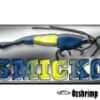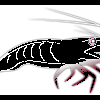Leaderboard
Popular Content
Showing content with the highest reputation on 09/08/14 in all areas
-
Just officially introducing a variety I've been working on for 9+ months...the "Green Balbaulti". Fell in love with this shrimp primarily for its colour, and more importantly it's inability to cross with the Cherry's and TB's/Tigers/CRS's....Etc, the perfect 3rd ornamental shrimp variety excl. our natives. Sharing tanks with my snowball colony The eggs are tiny and green .....PLEASE, don't ask how I extracted them....the answer will offend :o Info extracted from the net .... Scientific Name: Caridina cf. babaulti PH Range: 6.5 - 7.5 (7.3) Temperature Range: 20-28 (24) GH - 4-12 (8) KH - 0-10 (4) TDS - 80-350 (250) Life Span: 1 - 2 years *Numbers in brackets are my current WP. Green Shrimp History The green shrimps were given the name "babaulti" by Mr. Guy Babault who collected a large amount of new species of birds, fish and reptiles throughout his explorationmissions worldwide. He collected some of these shrimps in the freshw ater rivers of India in the year 1914. Green Shrimp Care The Green Shrimp is an undemanding shrimp in its care requirements. They should be kept in a well established aquarium with no predators. The most important factor for water parameter is stability and as long as none of the water parameters are in the extremes Green Shrimp should be happy and healthy. Green Shrimp Diet The Green Shrimp is an Omnivore. They are decent for aquarium algae control. Being algae eaters, if sufficient algae is not present, foods intended for aquarium fish and invertebrates can be used to supplement their diet. Another great supplement is blanched (boiled until soft) vegetables Green Shrimp Breeding The green shrimp breeds quite easily and generally have quite a few eggs. The eggs are smaller then other Caridina such as the Red Cherry Shrimp, and therefore the babies are also smaller and harder to raise. Breeding should occur in wel run tanks, that have been cycling for some time. Although these shrimp breed in large numbers, they are not the easiest to breed! Green Shrimp Behavior Green Shrimps a very non-aggressive. They spend most of the day grazing on plants, gravel and any other tank decorations for algae and other types of foods. Green Shrimps will get along very will with any other type of dwarf shrimp that is non-aggressive. When the Green Shrimp is kept in an aquarium that has no predators they are very active and only hide after molting (shedding exoskeleton to enable growth). I've been experimenting and attempting to acclimatise them to suit TB/Tiger WP, thus the shrimp survival % isnt great! BUT, in 1-2 more generations, I'm confident I'll get them breeding well to these WP. Definitely one of my favourite shrimps..... Will have these available after the next F generation, so in 1-2 months ....2 points
-
Just a quick list of killifish I am currently keeping and breeding. I have had a super busy 10-12 months so have not had a chance to breed numbers. I've only been breeding to keep my fish going. If anybody is interested in any particular fish let me know and I'll concentrate on them a bit more! The list is for you Mick! ;) Ones I breed currently Fundulopanchax gardneri Aquarium Strain (if a gardneri is sold/traded without a location code it is automatically regarded as Aquarium Strain) Fundulopanchax gardneri N'sukka Fundulopanchax gardneri Udi Berge Fundulopanchax gardneri Makurdi Fundulopanchax gardneri P82 Fundulopanchax gardneri nigerianum Fundulopanchax gardneri Gold Fundulopanchax gardneri Albino Fundulopanchax scheeli Aphyosemion striatum Aphyosemion australe Chocolate Aphyosemion gabunense boehmi Scriptoaphyosemion cauveti Chromaphyosemion bitaeniatum AMAR11 Chromaphyosemion bitaeniatum Lagos Chromaphyosemion bitaeniatum Ijebu Ode Chromaphyosemion poliaki Chromaphyosemion poliaki Bolifamba Chromaphyosemion poliaki Mile 8 - possibly Chromaphyosemion volcanum Mile 8 Chromaphyosemion volcanum Ekondo Titi Chromaphyosemion splendopleure Epiplatys sexfasciatus AMAR11 Epiplatys guineensis Epiplatys dageti monroviae Aplocheilus panchax Aplocheilus blockii Ones that I either acquired new or breeding is sparodic Fundulopanchax deltaensis Fundulopanchax sjoestedti Fundulopanchax filamentosum Fundulopanchax walkeri spurelli Aphyosemion celiae Scriptaphyosemion brueningi Ones that I have that are not likely to be available any time soon (I would be interested in more of some of these to increase my chances of breeding them) Fundulopanchax cinnamomeum Aphyosemion schioetzi Aphyosemion australe Gold Chromaphyosemion bivittatum Funge Nothobranchius ruudwildakampii Nothobranchius guentheri Nothobranchius guentheri Blue Simpsonichthys constanciae Believe it or not, there are some killifish species in Australia that I do not have!!!1 point
-
Hi all, I consider the blue cherry to be the single most sought after variant, with this In mind I have some of these to start a project and get them breeding true. I was given a headstart by acquiring 10 specimens that are F3 from blacks. Firstly the tank I'm using a 3x15x18 with gravel in various colours and sizes, mostly coffs harbour gravel with black and white over the top. I have a piece of mangrove root as a feature that will have peacock moss growing over once grown in, the peacock moss is also going to be a foreground ground cover. The middle row of plants blyxa japonica will also grow outwards and only grows around 8-10cm tall. I have two anubias at the back. Heated to 25 degrees and filtered by an Aquael internal filter. This is a pic of the tank followed by some pics of the shrimp. I am hoping for them to be breeding true by the 8th generation and I will keep this thread updated. These are the only three shrimp i seen tonight, as I see more i will post more pics. Cheers mick Just found another couple This one's berried woohoo1 point
-
The initial stock on this quest evolved from the blue velvets, red rill blue base.....selective breeding for approx 3-4 generations. ​Through natural mutations, "blue's" from black & brown cherry were added to the breeding stock. The results, were a culling rate of 80-90%. Frustrating at the best of times, but decided that this journey had to take place to add the depth of colour etc.... Eventually natural mutations via my carbon rilli were added to the project. These were selectively picked for their body coloration, with minimal rill pattern in existence as possible. The results after 1-2 years of selective breeding.... Ive recently added Gbang's blue dream to the colony, to strengthen their coloration, and to improve them breeding true. Looking forward towards the next 3-5 generations, were I expect them to do so...... The quest continue's .......1 point
-
Super excited, new generation emerged......Not entirely sure whether they should be directed towards my spotted head pinto project. Loving the colour/shade separation, trust the division will be maintained. Time will tell..1 point
-
Them two are my best but the red covers most of the body rather than just the head. I will try for a better pic but I have moved them to a moss laden tank so I don't play with them too much and disturb them. Plus I wanted that tank for something else. The next step is to try and find a red wine that I can buy or trade to get so I can strengthen the red colouration then go back across snow white and try to snag a couple that keep the head colour but have the white body and then a few generations of refinement. Can't wait to see what you've got bb, you are usually at the next level from me. If i can get the shrimp i need i think i am around 10 generations away from perfection. Cheers mick1 point
-
I've been conducting several experiments over 12+ months with water parameters, without really much success in improving their colony number.... Plus it's perhaps the most neglected tank ATM... I will re-focus on them and get them out to SKF members soon....1 point



